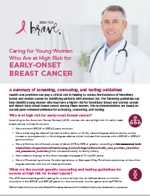Strategies for Managing Risk
Preventive Screening Recommendations for Women at Increased Risk for Hereditary Breast and Ovarian Cancer
The National Comprehensive Cancer Network (NCCN) and American Cancer Society (ACS) offer recommendations for preventive measures that can be taken once risk for hereditary breast and ovarian cancer has been identified. Health care providers can consider these recommendations, taking into account both the potential benefits and harms of a broad range of clinical preventive services for women with an increased risk of breast cancer, such as screening, counseling, and preventive medications.
What are the preventive screening guidelines?
The National Comprehensive Cancer Network (NCCN) recommends screening for women with a BRCA1 or BRCA2 mutation or a first-degree relative who has a BRCA1/2 mutation, even if the patient has not been tested for BRCA1/2 mutations.
The NCCN recommends that women at high risk get a mammogram and breast MRI every year starting at age 25 to 40, depending on the type of gene mutation and/or youngest age of breast cancer in the family. The NCCN also suggests that women at high risk have clinical breast exams every 6 to 12 months beginning at age 25. These women should also consult with a health care provider to weigh the pros and cons of 3D mammography and learn how to identify changes in their breast.
The American Cancer Society (ACS) recommends that women at high risk should get a mammogram and breast MRI every year. The ACS suggests that women at high risk begin their screening at age 30 or an age recommended by their health care provider and continue for as long as they are in good health. Since there is limited evidence for the best age to start screening, ACS believes that this decision should be shared by the patient and her health care provider to ensure personal circumstances and preferences are taken into account.
What are additional risk management strategies?
The strategies to manage and reduce risk for women with a confirmed genetic susceptibility to breast and ovarian cancer include earlier, more frequent, or additional and intensive cancer screening modalities (such as breast MRI); risk-reducing surgeries (such as mastectomy or salpingooophorectomy), and medications (such as tamoxifen). Personal preference is an important factor in patients’ decisions about risk-reducing strategies.
Additional Resources
- Page last reviewed: June 15, 2017
- Page last updated: June 15, 2017
- Content source:



 ShareCompartir
ShareCompartir
